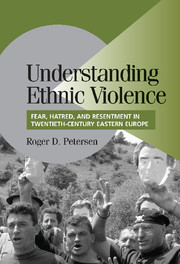Book contents
- Frontmatter
- Contents
- Preface
- 1 INTRODUCTION
- Part One Theory
- Part Two Comparisons: The Baltic States in the Twentieth Century
- 5 BALTIC 1905
- 6 IN THE WAKE OF BARBAROSSA
- 7 THE RECONSTRUCTION OF INDEPENDENT STATES
- 8 ACROSS THE CENTURY
- 9 CZECHOSLOVAKIA, 1848–1998
- 10 YUGOSLAVIA
- 11 CONCLUSION
- Bibliography
- Index
- Cambridge Studies in Comparative Politics
7 - THE RECONSTRUCTION OF INDEPENDENT STATES
Published online by Cambridge University Press: 05 June 2012
- Frontmatter
- Contents
- Preface
- 1 INTRODUCTION
- Part One Theory
- Part Two Comparisons: The Baltic States in the Twentieth Century
- 5 BALTIC 1905
- 6 IN THE WAKE OF BARBAROSSA
- 7 THE RECONSTRUCTION OF INDEPENDENT STATES
- 8 ACROSS THE CENTURY
- 9 CZECHOSLOVAKIA, 1848–1998
- 10 YUGOSLAVIA
- 11 CONCLUSION
- Bibliography
- Index
- Cambridge Studies in Comparative Politics
Summary
As Germans and Jews had been eliminated through murder, deportation, or flight during the 1940s, ethnic relations in the Baltic in the post- Communist period (post-1991) have primarily involved interactions among the eponymous peoples, the Russian diaspora, and in Lithuania, the Polish population in the Vilnius region. No significant ethnic violence occurred during the reestablishment of independence. Given this fact, this chapter, in effect, changes the dependent variable. Here, the puzzles involve state policies of the early and mid-1990s. Fear, Hatred, and Resentment still provide the framework for analyzing variation, but here that variation is measured by differences in the formation of institutions. For these cases, emotion may not be as dramatic or intense, but it still motivates action and influences outcomes. The linkage between emotion and individual actions may not be as tight or direct in this chapter as in the sections focusing on violence. However, by expanding the approach, this chapter tests the ability of an emotion-centered explanation to address a wider spectrum of ethnic politics.
The Baltic states' ethnic policies have exhibited considerable variation. To take one fundamental example, the three Baltic states showed significant differences on the question of citizenship. In Lithuania, all residents were granted automatic citizenship regardless of ethnic history. In Estonia, the Supreme Council reinstated Estonia's citizenship of 1938. All those who could not trace their roots back to the interwar republic were required to go through an application process and, most importantly, were required to know the Estonian language.
- Type
- Chapter
- Information
- Understanding Ethnic ViolenceFear, Hatred, and Resentment in Twentieth-Century Eastern Europe, pp. 137 - 164Publisher: Cambridge University PressPrint publication year: 2002
- 1
- Cited by



